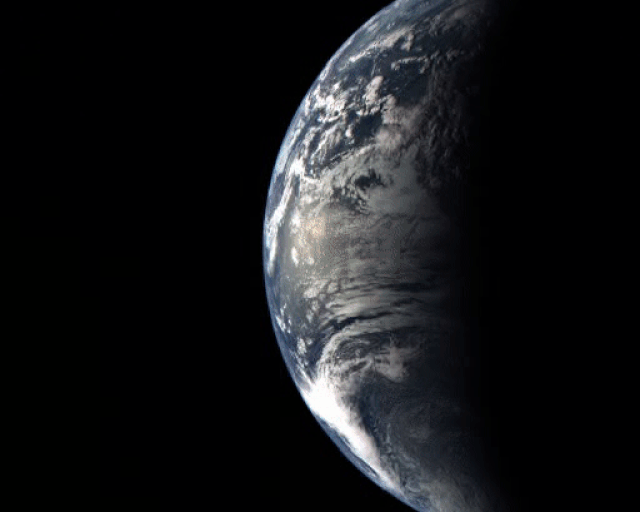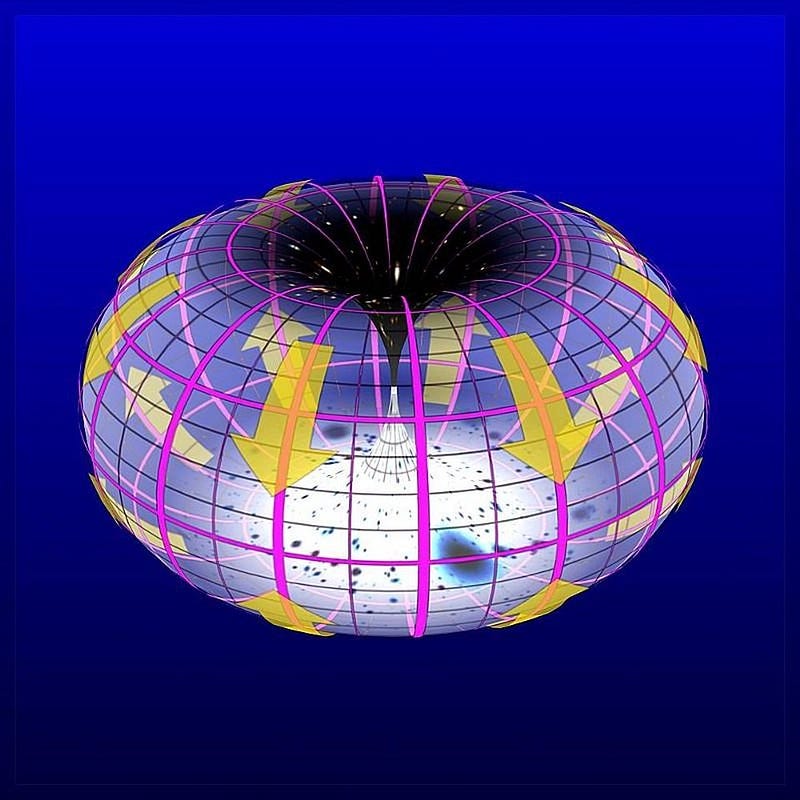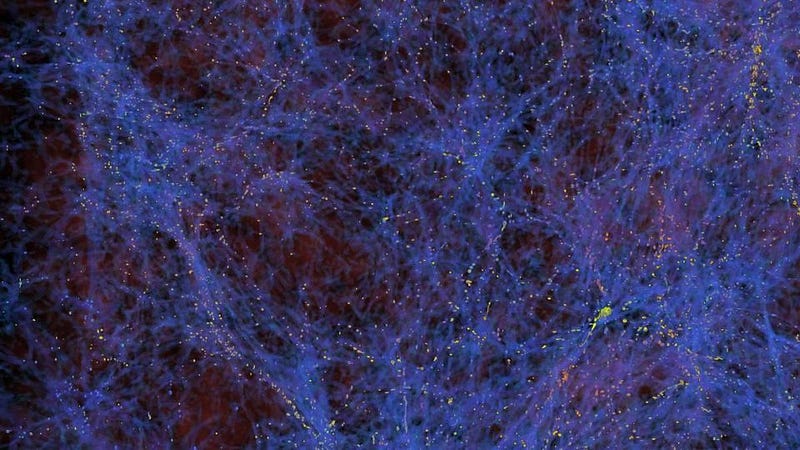Would A Long Journey Through The Universe Bring Us Back To Our Starting Point?

If you traveled in a straight line for far enough, would you come back to where you started?
If you were to set out on a journey from anywhere on Earth’s surface, and traveled in a straight line for far enough, you’d eventually wind up right back where your journey began. After traversing approximately 40,000 kilometers (25,000 miles) — crossing mountains, oceans, deserts, etc. — you’d have completed one entire journey around the surface of our planet. The eventual destination you’d arrive at would be unambiguous: it’s the same as your starting point.
Could it work the same way in space? If you got into a starship, set off in one direction, and traveled as far as you liked, would you eventually return to your starting point? It’s a fascinating question to explore. Even though all signs seem to point towards “probably not,” there are actually two ways that the answer might turn out to be yes, after all.

When we step out of our homes and look at the Earth around us, it generally appears to be flat. For as far as we can see in every direction, from everywhere human beings exist on Earth’s surface, we cannot directly detect the curvature of the Earth. This doesn’t mean that the Earth isn’t curved; it means that if we want to detect and measure exactly how the Earth is curved, we need to look at it on larger scales than our eyes can perceive from a single vantage point.
Fortunately, there are a number of ways we can effectively gather the information necessary to demonstrate the curvature of Earth. We can measure astronomical sights from different latitudes and longitudes. We can perform triangulation measurements from different locations at the same time. Or, most directly, we can travel to a high enough altitude so that we can view our planet’s curvature directly.

When it comes to the Universe, the situation is only a little bit more complex. From our perspective in the Milky Way, even with all the probes we’ve sent out across (and even out of) the Solar System, we cannot directly measure whether the Universe is flat or curved.
What we can do, however, is measure the light that comes from distant sources that are millions or even billion of light-years away. If the Universe were curved, those light paths would be curved in a very particular way; if the Universe were flat, those light paths would exhibit different patterns. From galaxies, galaxy clusters, and even the leftover light from the Big Bang itself (the cosmic microwave background), we’ve indirectly determined that the Universe is flat. Or, if it’s curved (like Earth is), the radius-of-curvature is at least hundreds of times larger than the size of the observable Universe.

On the surface, this seems to imply that the Universe is flat rather than curved. At least, on the scales at which we can measure our Universe — about 46 billion light-years in all directions from our vantage point — there’s no indication that the Universe is curved. But being positively curved so that parallel lines converge, the way that parallel lines (e.g., of longitude) drawn on the surface of the Earth eventually meet, isn’t the only way our Universe could be curved.
You could imagine, instead, that our Universe were shaped like a torus: a long cylinder whose two ends are connected to form a donut-like shape. Along the surface of the torus, parallel lines never meet and the measured distortion of distant light would be perfectly consistent with a flat Universe. But if you traveled far enough in any straight line, you would eventually return to exactly where you set out from.

Could our Universe be shaped exactly like this? It’s a possibility that isn’t ruled out by the data. The only way we know of to distinguish a torus-like Universe from one that we think of like a three-dimensional grid would be to find an observational signature of that unusual mathematical shape (known as topology).
What would this look like?
It would mean, if we went to deep galaxy surveys, large-scale clustering maps, or even the leftover radiation from the Big Bang, we could identify any region of space that appears in multiple places. If the Universe were shaped like a torus and were less than ~92 billion light-years from end-to-end, we would be able to identify any locations where the same features appeared in both places.

Unfortunately for us, the Universe doesn’t appear to be that way. We’ve constructed all-sky maps out to great depths, including an incredibly detailed view of the temperature mapping of the cosmic microwave background. The features we see are fantastically informative about the nature of the Universe, but definitively all represent unique regions of space. If the Universe does, in some way, curve back on itself, it can only do so on scales that are larger than we can perceive.
And even if it were the case, we’d never be able to traverse the entire Universe in that fashion. The reason is simple: the Universe is expanding, and the rate at which it’s expanding means that even at the speed of light there’s a limit to how far we can go. Although we can always travel for longer amounts of time — and reach arbitrarily close to the speed of light — objects that are presently more than 18 billion light-years away (about ~94% of objects in the observable Universe) are forever beyond our reach.

Still, it’s always possible that the Universe truly does curve back on itself like this, only on scales that are larger than we can perceive. It’s possible that if we could travel at an infinite speed — or the speed of our imagination — we would be able to perform such a task. Perhaps, if we traveled in a straight line for long enough, we truly would return to our starting point, just as if you fired a projectile at exactly the right speed on Earth (and neglected air resistance), it could wind up hitting you in the back of the head about 90 minutes later.
The reason this is possible is because of gravity: the Earth’s gravitational pull warps the fabric of space, which means that when an object moves in what appears to be a straight line, it’s actually following the curvature of the warped space it’s traveling through. If you were to travel with just the right trajectory in the vicinity of a massive enough object, it could even slingshot you around to return you in your original direction.

For most objects in the Universe, like planets, stars, or galaxies, their gravitational effects can only cause objects moving close to the speed of light to deflect slightly. The most spectacular instances of light-bending due to gravity — strong gravitational lenses — only deflect light by a tiny fraction of a degree.
It’s enough to create multiple images of distant object, owing to the fact that multiple light paths exist from the source to the destination, but not enough to cause light to do a U-turn. However, one class of object actually does have the capacity to make that happen: black holes. When light passes very close by the event horizon of a black hole, it can be deflected by enormous amounts, including by a full 180 degrees.

This was an enormously important component that went into the calculations of what the first image from the Event Horizon Telescope would look like, as the behavior of light near the event horizon of a black hole is far outside of our day-to-day experience. But if we had a spaceship with unlimited power capabilities, there’s always one trajectory we could take near any black hole that would slingshot us back from the direction we came.
That’s the only realistic way we know of — without assuming something speculative about the shape of the (unobservable) Universe and throwing away the constraints of the speed of light — that we could travel in a straight line and return to our starting point. The fact is that the presence of matter and energy curves space, and in some places, space is curved so severely that it can change an object’s trajectory significantly.
With the right choices, we could wind up practically anywhere we choose by launching a spaceship with the perfect trajectory and the right knowledge of black holes throughout the galaxy and Universe.

On a cosmic scale, there is no indication that the Universe is anything other than infinite and flat. There is no evidence that features in one region of space also appear in any other well-separated region, nor is there evidence of a repeating pattern in the Universe’s large-scale structure or the Big Bang’s leftover glow. The only way we know of to turn a freely moving object around is via gravitation slingshot, not from cosmic curvature.
And yet, it’s a legitimate possibility that the Universe may, in fact, be finite in extent, but larger than our observations can currently take us. As the Universe unfolds over the coming billions of years, more and more of it (about 135% more, by volume) will become visible to us. If there’s any hint that a long-distance journey would bring us back to our starting point, that’s the only place we’ll ever find it. Our only hope for discovering a finite but traversible Universe lies, quite ironically, in our far distant future.
Ethan Siegel is the author of Beyond the Galaxy and Treknology. You can pre-order his third book, currently in development: the Encyclopaedia Cosmologica.





